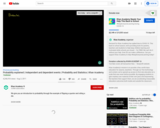
An introduction to probability through the example of flipping a quarter and rolling a die. it is a practice lesson.
- Subject:
- Applied Science
- Arts and Humanities
- Engineering
- Material Type:
- Lecture Notes
- Author:
- Khan academy
- Date Added:
- 09/13/2020

An introduction to probability through the example of flipping a quarter and rolling a die. it is a practice lesson.
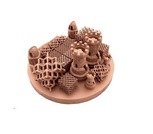
This resource contains materials related to Additive Manufacturing. Feel free to use any of the materials and modify them as needed for your class, If you modify them, please resubmit them to SLAM Resources.

This resource contains materials related to Additive Manufacturing. Feel free to use any of the materials and modify them as needed for your class, If you modify them, please resubmit them to SLAM Resources.

This resource contains materials related to Additive Manufacturing. Feel free to use any of the materials and modify them as needed for your class, If you modify them, please resubmit them to SLAM Resources.

A list of debate and discussion protocols for classroom use.
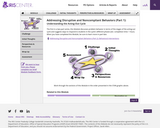
The first in a two-part series, this Module discusses problem behavior in terms of the stages of the acting-out cycle and suggests ways to respond to students in the cycle's different phases (est. completion time: 1 hour). When you have completed this Module, be sure to learn more in part two.
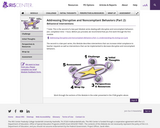
The second in a two-part series, this Module describes interventions that can increase initial compliance to teacher requests as well as interventions that can be implemented to decrease disruptive and noncompliant behaviors.

A Resource for Instructors of All Levels, Backgrounds, and Teaching Contexts
Short Description:
Addressing Evolving Needs with Universal Design for Learning (UDL) is a resource that will guide instructors of all levels, backgrounds, and teaching contexts to reflect on the evolving needs of students, and to implement UDL principles to create more supportive, inclusive, and accessible learning environments for all. In addition to introducing key UDL concepts, this resource includes practical applications, tools, and discussion/reflection prompts for instructors of all levels. This resource can be used individually or in group contexts.
Long Description:
Addressing Evolving Needs with Universal Design for Learning is a resource that was created following the success of a cohort-based online practicum that was offered to faculty, instructors, and staff at Northwestern University. This resource is designed for instructors of all levels, backgrounds, and teaching contexts to reflect on the evolving needs of students and instructors, with an emphasis on mental health. Following the events of the past couple of years, explore how elements of course design can have varying impacts on students, and learn to implement Universal Design for Learning (UDL) principles to create more supportive, inclusive, and accessible learning environments for all.
This resource draws on expertise and experience from around the Northwestern University to explore practical ways to implement UDL solutions in syllabi, LMS pages, course materials, assignments and assessments, and learning experiences.
Word Count: 4549
(Note: This resource's metadata has been created automatically by reformatting and/or combining the information that the author initially provided as part of a bulk import process.)
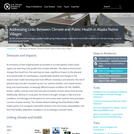
As emissions of heat-trapping bases accumulate in our atmosphere, Earth's polar regions are warming more quickly than at lower latitudes. The rapid environmental changes that result from this warming can have a significant impact on the physical and mental health of rural Alaskans: unpredictable weather and changes in the seasons have made harvesting food more difficult, hazardous, and stressful. The risk of physical injury has also increased, as poor ice, extreme weather, and coastal erosion bring new travel hazards. Increasingly difficult harvest conditions for fish, shellfish, berries, caribou, and sea mammals have also increased concerns about food security. Additionally, declines in snow pack, the threat of drought, changes in lake and river conditions, and damage and disruptions to community water systems have prompted concerns of water security. The climate-related challenge faced by Alaskas tribal health system is to recognize new health stressors and community vulnerabilities, and then find healthy adaptation strategies in an increasingly uncertain future.
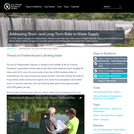
In 2012, water managers in Fredericktown, Missouri, saw their city's main source of water dwindle. They used the EPAs Climate Ready Water Utilities program to consider options and develop plans to protect their water source.
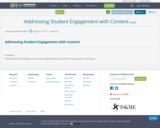
Rubric Element 1.5
Students are actively engaged with the content for the majority of the lesson.
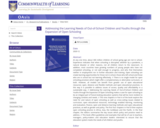
At any one time, about 300 million children of school going age are not in school. Experience indicates that when schooling is disrupted, whether by a pandemic, a natural disaster or other reasons, not all children return to the classroom. In addition, most countries have growing numbers of young people who have not completed schooling, or not well enough to progress, and who find themselves neither in employment nor in further education and training.
Open schooling can create learning opportunities for those not in school, those who left school and those who are in school but not learning effectively. There is no single model for open schooling provision which might offer a complementary or alternative curriculum, or both. However, all models can benefit from greater use of open educational resources; open, distance and flexible methods and open educational practices. In this way it is possible to address issues of access, quality and affordability in a sustainable way.
This book offers guidelines and examples that will be of use to teachers, managers, policy-makers and education leaders interested to ensure that the education system meets the needs of all children and youths.
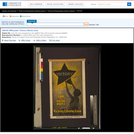
Poster showing a woman attaching a triangle to complete a five-pointed star "Victory." Woman's Committee, Liberty Loan Organization, Seventh Federal Reserve District. W.L.L.C. X5.
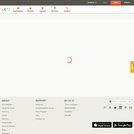
This course features a video review of addition up to the sum of ten for first graders.
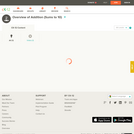
This short video and interactive assessment activity is designed to teach second graders an overview of addition (sums to 10).
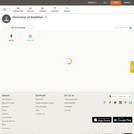
This short video and interactive assessment activity is designed to teach second graders an overview of addition.
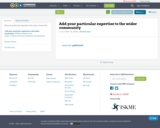
Add your particular expertise to the wider community
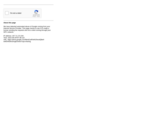
This is a presentation on Non verbal communication
1-What is communication?
2. What is Verbal and Non-verbal Communication?
3. Non-verbal Communication examples
4. Your body language may shape who you are
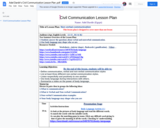
1-Students answer the questions about verbal and nonverbal communication.
2-Our body language may shape who we are.
By the end of this lesson, students will be able to:
• Define communication, verbal and non-verbal communication styles
• List at least three different non-verbal communication styles.
• Listen respectfully and positively to one another
• Use body language during interactions with others.
• Summarize a video on the power of body language.